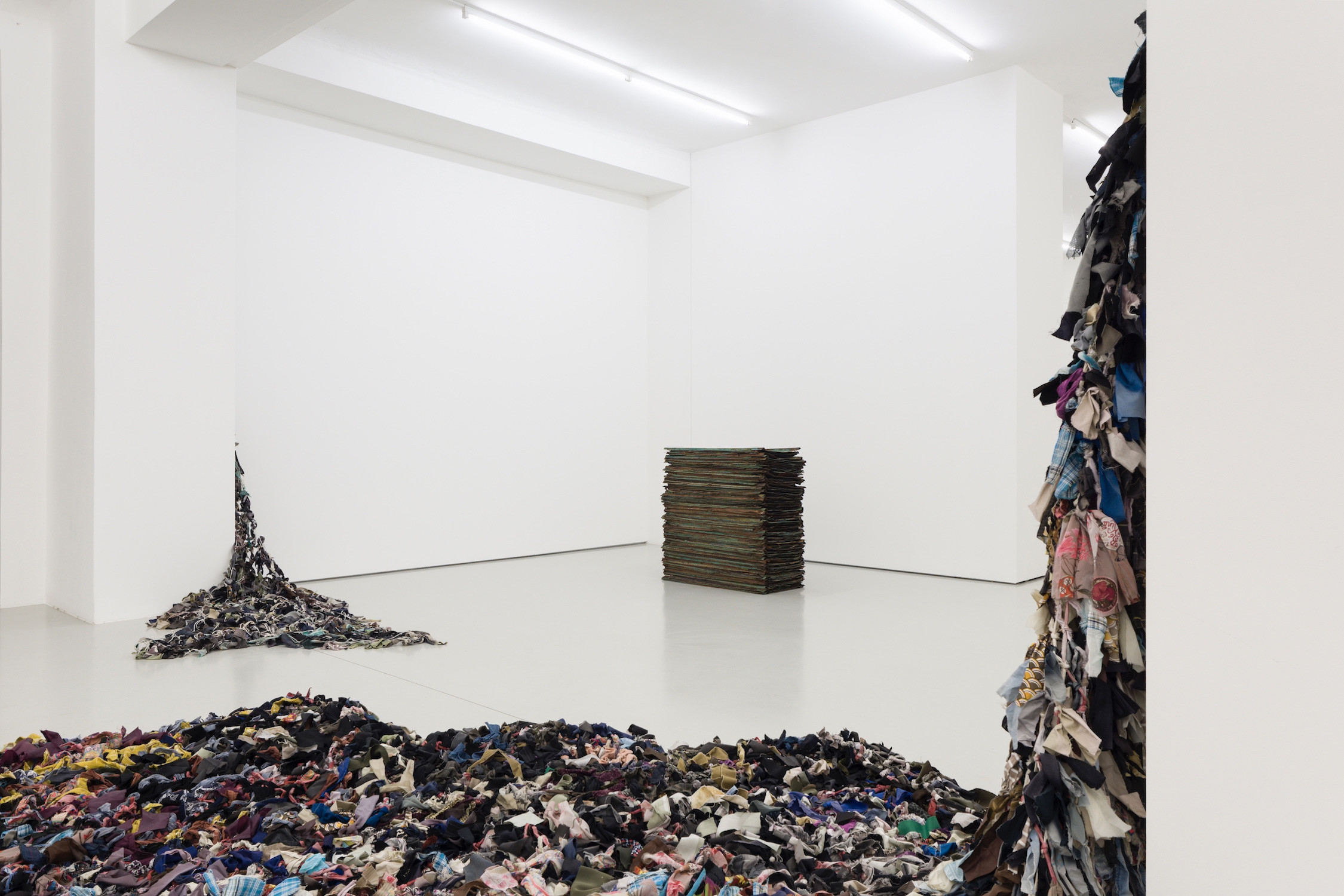
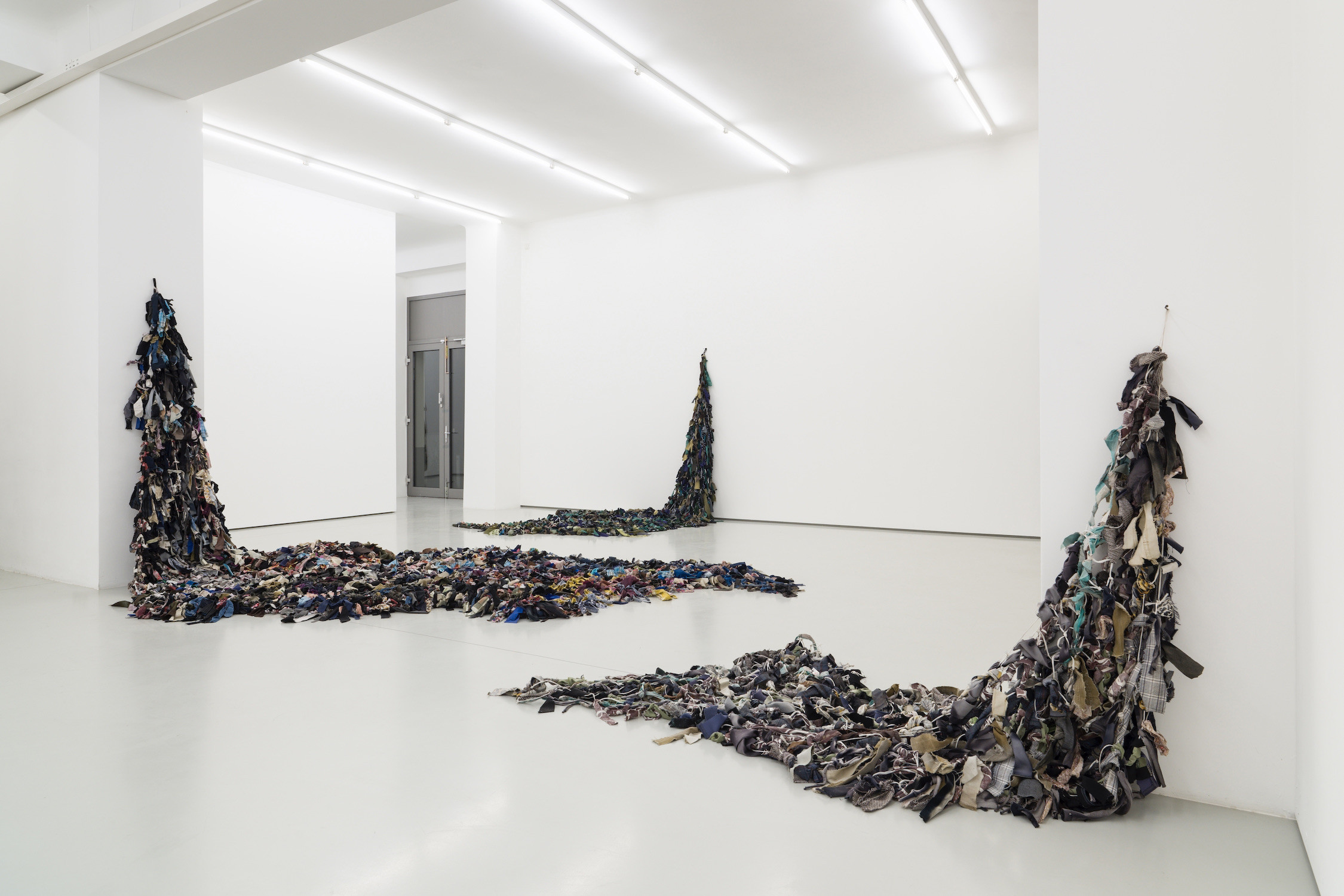
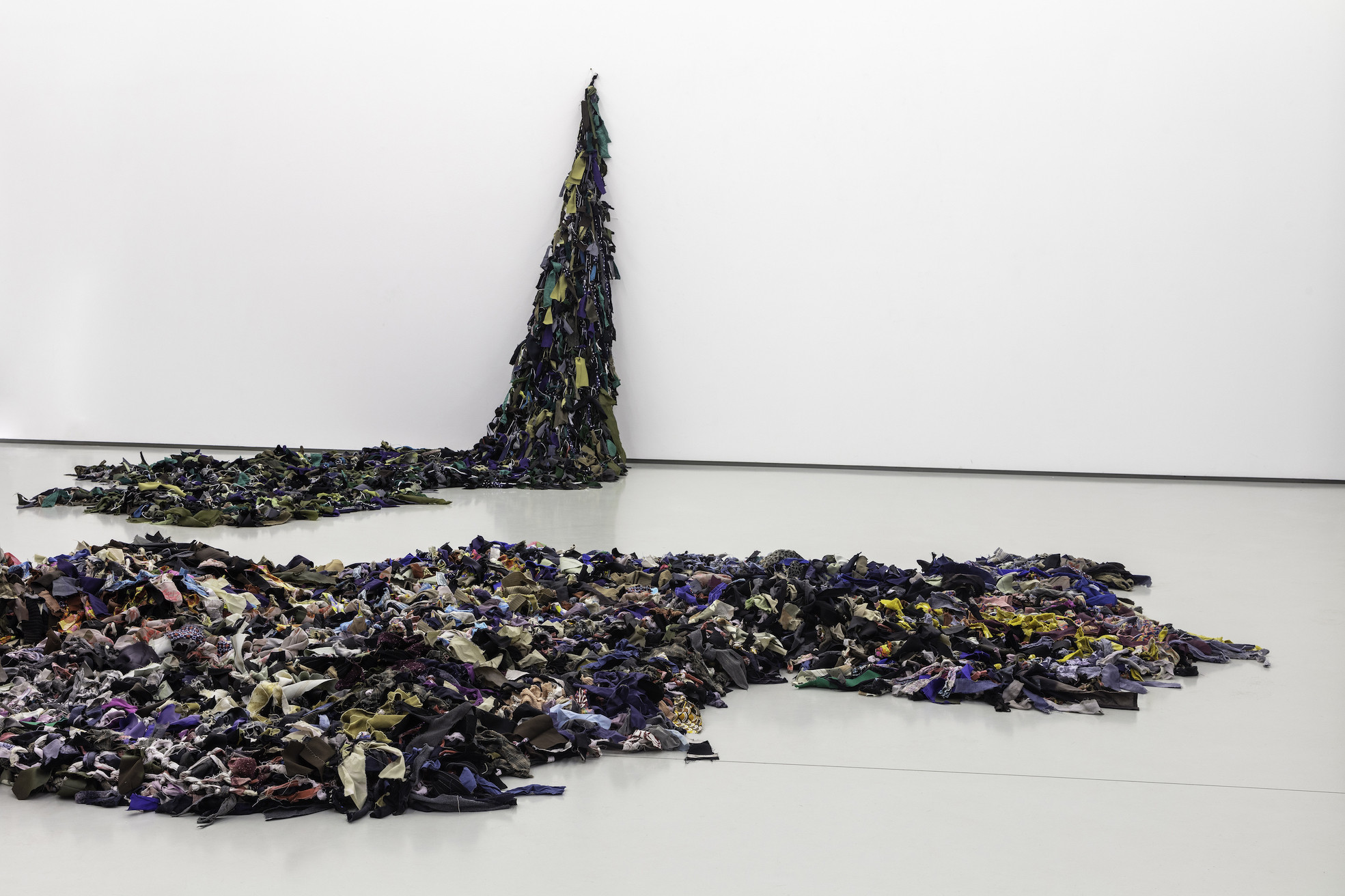

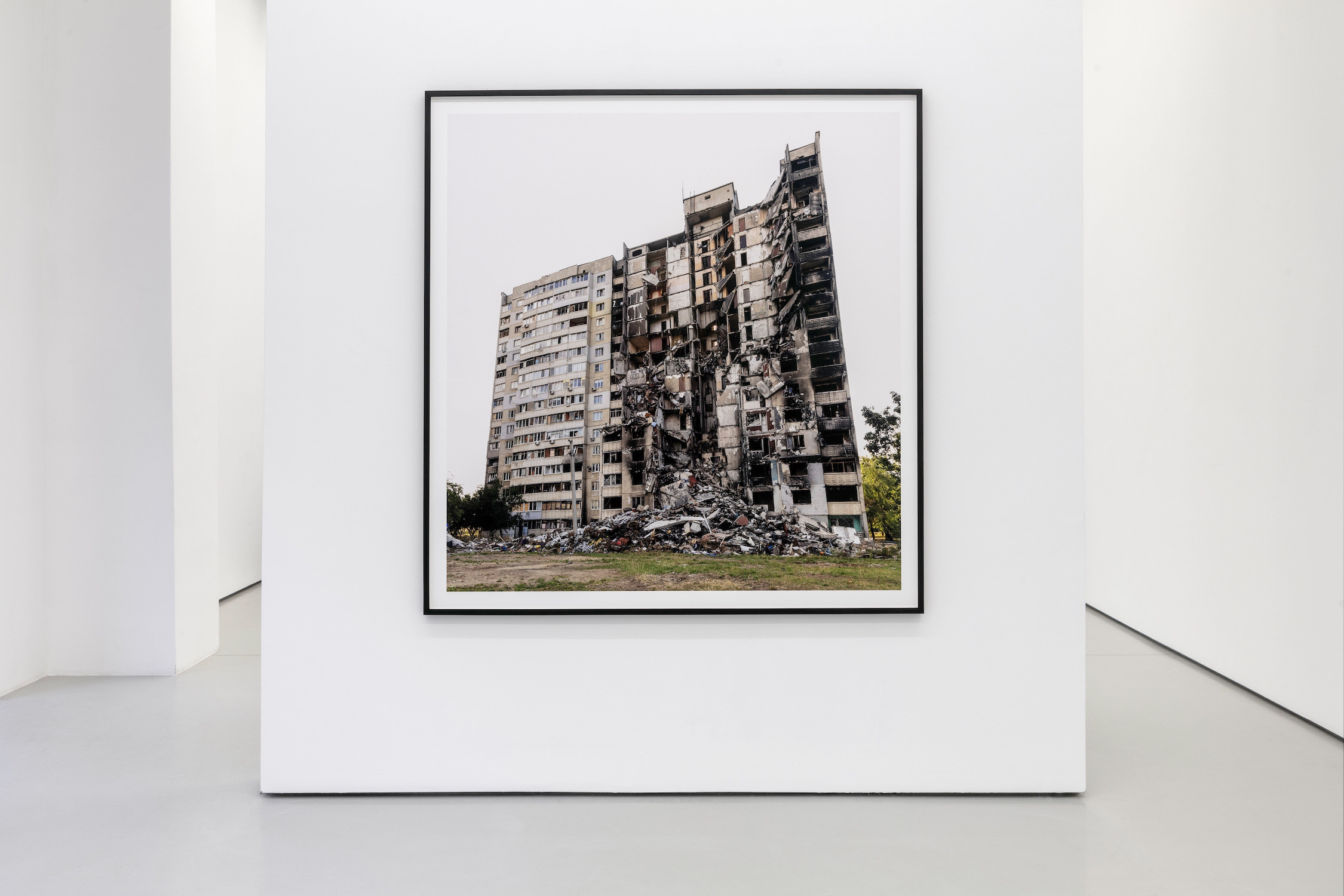
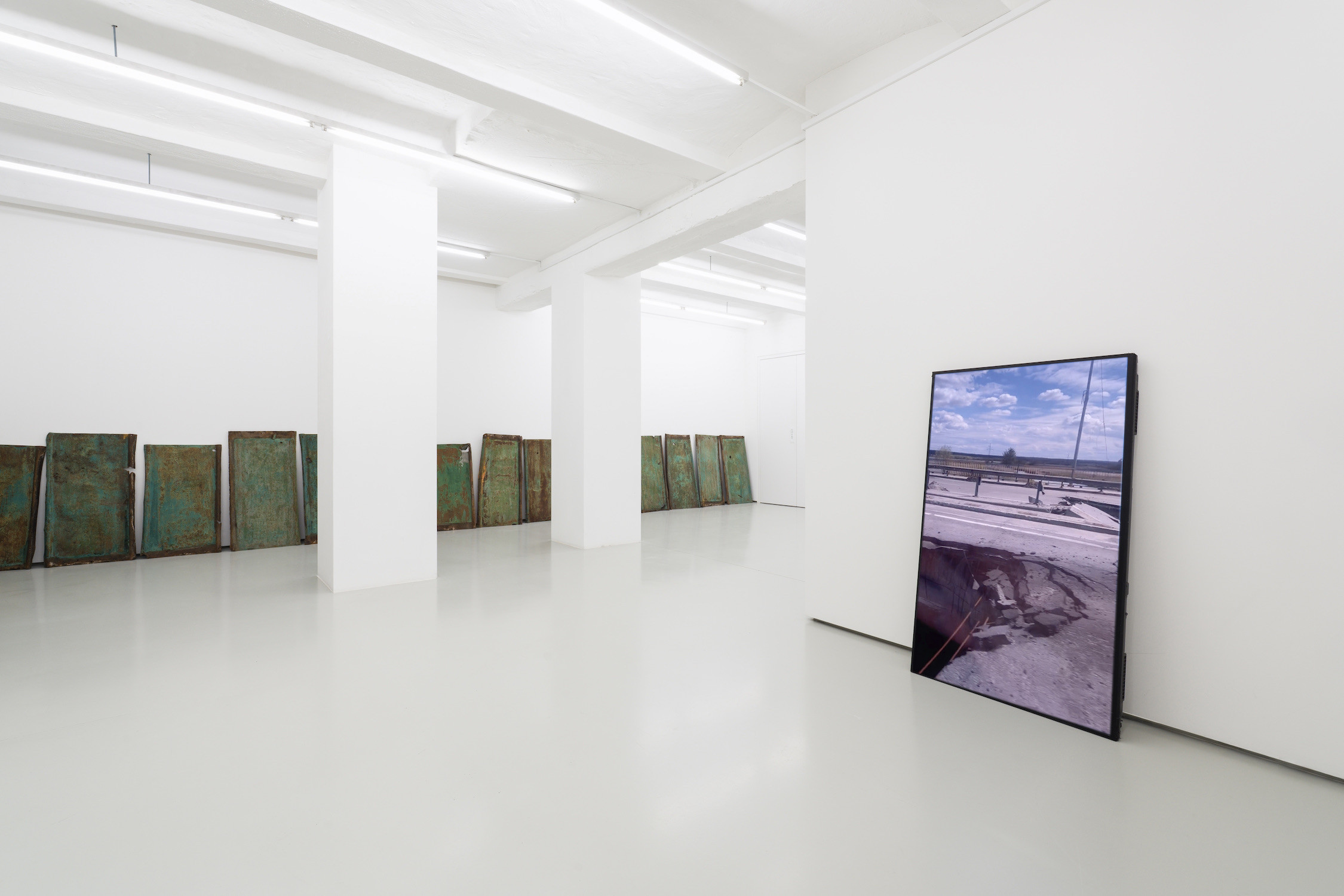
Fabian Knecht
Der Weg des größten Widerstandes
(The Path of Most Resistance)
Curated by Dehlia Hannah
From mid April until June 2022 Fabian Knecht planned to walk from Berlin to Moscow, in order to arrive just in time for his solo exhibition at the city’s progressive Szena gallery. The walk itself would have been the exhibition’s central work—an act of artistic determination expressed through a substantial commitment of time and bodily labor, compressed into the bare form of his presence at the opening. Before Knecht could set off, the Russian invasion of Ukraine on February 24th, rendered this plan unacceptable. Instead, by early March Knecht was in western Ukraine, meeting with artists who had become soldiers overnight—friends made in 2016 while producing early works in his Isolation series. What they needed, he learned, was not food and clothing but bullet proof vests, tourniquets, and tactical medical packs. Evacuated of artistic motive by the exigencies of the situation, Knecht returned to Berlin and took up collection for packages of defensive body armor and lifesaving equipment, which he promised to deliver himself. This unsettling request, issued to friends and patrons, accompanied by the legal proviso that helmets and bulletproof vests had been reclassified as humanitarian rather than military aid, yielded over 100 kits, which Knecht delivered to Kyiv and other locations on the front lines during the opening week of the Venice Biennale.
It was through these gestures of solidarity that Knecht became acquainted with members of the Kyiv-based volunteer group Livyj Bereh(Left Bank), whose work ranges from reconstructing houses to sourcing vehicles and protective equipment for military units. In the intervening period, he made seven subsequent visits to the country, deepening his involvement with the group and communities that had previously hosted his own artistic endeavors. Having abandoned the imperatives of artistic production (and consumption) under the pressure of a more compelling ethical commitment, Knecht’s path converged with the unshakable conviction of every Ukrainian: to resist Russian aggression with every fibre of their being and resource at their disposal. From this, a new aesthetic clarity was born. There, he joined them for a few steps on Der Weg des größten Widerstandes (The Path of Most Resistance).
Upon entering the gallery, visitors must choose one of the tributaries created by large textile works that spill down from the walls and across the floor. The exhibition is a labyrinth. While tracing a path between the carefully worked detritus of war, the curious spectator is afforded no disinterested viewpoint. And yet this is not a confrontation—a shock that pressures us to seek comfort and reconsolidate ourselves. It is, rather, a matter of taking up positions. Here, military and aesthetic operations transmute into one another: the positions we take up in the gallery mirror—and perhaps transform—where we stand in the world.
At our feet there lies a thick rag carpet, tufted with strips of blue, green, black and brown; occasionally warmed by streaks of floral or paisley patterns: the remains of an old blouse or bedsheet. Every scrap of fabric woven into the war effort, by hands young and old, from across Ukraine and beyond. These ubiquitous camouflage nets are used to disguise potential targets from Russian drones, bombs and surveillance systems. In seasonal colors, rural and urban palettes, the nets are products of communal handwork—creativity driven by the urgency of their function. Although their purpose is to render a location indiscernible from its surroundings, they disclose an uncanny intimacy. Some of the nets are already dusty from use. Others, fabricated for Knecht as artworks by volunteers in the village of Pidloztsi, where he stayed on some of his visits, and in his Berlin studio, have been returned to the battlefield for use as camouflage—on aesthetic grounds. Lachen ist verdächtig (Laughing is suspicious) embodies an exchange not just between Knecht and his collaborators, but between art and utility. Even as camouflage, their use is constantly changing: with location, season, and the specific patch of the world that they are made to cover. Their aesthetic depth arises from this nexus of context and content, generic and site-specific.
By nominating camouflage nets as artworks, Knecht mobilizes the whole apparatus of the artworld—it’s critical and viewing conventions, and its systems of aesthetic and monetary valuation. This critical aesthetic is not unusual for the artist. More than any medium or topic (although war and nature are important themes), a key feature of Knecht’s oeuvre is his interrogation of the gallery as a space of encounter with art objects, and their representational, political or conceptual content. Through many iterations, his Isolation series deploys an ersatz gallery, replete with bright fluorescent lights, to interrogate how aesthetic attention is granted to particular sites and not others. By demarcating the cut of the landscape and dictating a point of interest, the series exhibits the focusing power of the white cube itself. But this is not the only example of Knecht’s critical operation upon art’s logic. Consider the early work, Isolation (Sockel) 2016, also created in Ukraine, which presents a concrete pedestal upon which a statue of Lenin once stood: a double framing of art’s absence. In another work he set smoke billowing from the roof of a museum. Elsewhere, he let a live rat loose in a hall of landscape paintings, left a suspicious bag at the gallery door, and repainted acid burns inflicted on master paintings. He has even exhibited an actual operating table (Sektion, 2018). In short, Knecht mobilizes ‘an atmosphere of artistic theory, a knowledge of the history of art: an artworld’ (in the memorable words of Arthur Danto) in order to valorize artifacts and impressions of war into artworks, whose sale, in turn, will directly fund the volunteer work Livji Bereh.
Lifting our gaze from the floor coverings, it comes to rest upon a tall stack of rusty green corrugated roofing sheets—pieces of discarded scrap metal left over after a bomb blast. In its dimensions and position within the gallery, Das gebrochene Ar (The broken are) I recalls an empty pedestal, similarly positioning the viewer within the gallery apparatus. The title is a reference to Walter de Maria’s The Broken Kilometer (1979), a minimalist sculpture consisting of five hundred brass cylinders, permanently installed in a New York City storefront. An are is a historical unit of measurement equal to 100 square meters: a domestic measure, in this case, an actual rooftop. In a second version of the work, an equal number of roofing sheets lean individually against three walls of the gallery, bearing visible dents and shrapnel holes. On view in the gallery office and as an Augmented Reality object projected on the lawn of Berlin’s Reichstag, Kukhari Pool, a 3D scan of a bomb crater indicates how the are was broken—a digital objet trouvé.
In the next room, five lengths of thick hemp fabric, a textile typically used in delicately embroidered Ukrainian formal dress, hangs from the wall. Blackened by paint that Knecht created by scraping rust and soot off of incinerated tanks, they appear as if they had been used to wipe down the wreckage: Der Tod lässt sich nicht auswaschen (Death cannot be washed out). On the wall opposite stands a large-format photograph of a bombed apartment building, Natalii Uzhvii Straße 82, Charkiw (Natalii Uzhvii Street 82, Kharkiv). The special context of this image is that the building was bombed in the earliest days of the war, demonstrating that Russian aggression targeted civilians from the beginning. It is clear from the building’s tilt that the photograph was taken from the ground. Yet, hung at eye level, our vantage point is closer to that of a drone, or a bird. There is something particularly unnerving about the exposed domestic interiors, even as such photos, from Ukraine and other zones of conflict, flash relentlessly across newspapers and screens. Together, the works reassemble material memories in an aesthetic testament to the moral clarity that undergirds the Ukrainian resistance.
Descending into the basement gallery, one is delivered in front of a photograph of a bombed-out section of a highway running through a forest (Desna Brücke 30. April, 2022). With formal echoes of Knecht’s Isolation photographs, the stark composition features the ruined remains of what was once a way—destroyed by Russian forces to cut off access to Chernihiv. Around the frame’s edges, trees budding with pale green leaves betray that it is early spring. From an adjacent darkened room, camouflage spills out onto the floor, beckoning us to tread upon the artificial terrain within. Finding a comfortable position on the floor, one stares upwards toward a rectangular patch of blue sky, framed by the four standing walls of a bombed out apartment building and a few swaying pieces of rebar. In a nearly 20 minutes video projection, with a shifting soundscape, Borodyanka Sky Space offers meditative respite from the surrounding destruction. In spite of the ominous context, this found skylight operates much like eponymous works by James Turell, focusing and amplifying perception of light conditions, clouds, birds, and the haunting sound of twisted metal swaying in the air. Perhaps even the whir of an engine threatening to appear in one’s line of sight. At stake, as in Turell’s Quaker-inspired—perhaps paradigmatically pacifist–spaces is the imperative of maintaining a modicum of inner peace even within a war zone.
At the center of the exhibition’s labyrinth there is a turning point: the visitor’s path continues virtually into a montage of handheld video clips from Knecht’s traversal of sites across Ukraine. The titular work of the exhibition, Der Weg des größten Widerstandes (The Path of Most Resistance), takes us driving along roads pockmarked by craters, strewn with abandoned tanks and bomb casings, down an elevated highway, right up until it drops away. Constantly in motion, with the shifting perspective of a handheld device, the work offers important contextual clues about new as well as older artworks. Boots sink into swamp grasses, revisiting the site at which Knecht erected Isolation (Riverbed) in 2016. The destruction of imperial monuments, evoked by the empty concrete pedestal, takes on new urgency. A woman clad in a white dress flits defiantly across a ghostly plaza in the twilight. The exuberant presence of puppies and other animals in the lives of soldiers and residents. Those of us familiar with Knecht’s prior work are reminded that we have honed our aesthetic perception on Ukrainian landscapes. Through the Isolation series, we have probably looked more closely at a muddy swamp or a luscious field of yellow flowers there than at the ground at our feet. Yet now these sites take on a new significance, as political geography supersedes ecological particularity. Now, more than ever, we need to look outside the box. Thus does art give rise to a more thorough-going political commitment.
Dehlia Hannah
The artist would like to thank Vlad Sharapa, Ihor Okuniev, Viktor Kovalenko, Oleg Yukhimyuk, Markus and Leveke Schütte.
With the support of and to support Livyj Bereh.